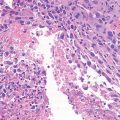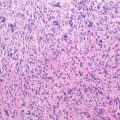Piero Picci, Marco Manfrini, Nicola Fabbri, Marco Gambarotti and Daniel Vanel (eds.)Atlas of Musculoskeletal Tumors and Tumorlike Lesions2014The Rizzoli Case Archive10.1007/978-3-319-01748-8_32
© Springer International Publishing Switzerland 2014
32. Biology of Central and Peripheral Chondrosarcoma
(1)
Laboratory of Experimental Oncology, Istituto Ortopedico Rizzoli, Bologna, Italy
Abstract
Central and peripheral chondrosarcomas (CHS) present complex karyotypes and a genetic instability that results from early specific gene mutations followed by secondary genetic changes such as TP53 mutation and CDKN2 deletions.
Central and peripheral chondrosarcomas (CHS) present complex karyotypes and a genetic instability that results from early specific gene mutations followed by secondary genetic changes such as TP53 mutation and CDKN2 deletions.
Central CHS may develop from enchondroma where Indian hedgehog (IHH) and parathyroid hormone-like hormone (PTHLH) signaling pathways, involved in longitudinal growth of long bones and chondrocyte differentiation, are deregulated. Moreover, the frequent mutations in isocitrate dehydrogenase genes IDH1 and IDH2 found in enchondroma and central CHS suggest that these may be considered as early events in tumorigenesis, although further studies are needed to reveal the exact mechanism by which these mitochondrial deficiencies lead to tumor development (Szuhai et al. 2012).
Additional genetic or epigenetic alterations occur during progression toward central CHS including activation of signaling pathways IHH/PTHLH/Bcl-2 (Tiet et al. 2006); Src, Akt, and PDGFR (Schrage et al. 2009; Grignani et al. 2011); IGF; as well as hypoxic and glycolytic pathways (Bovée et al. 2005, 2010). An important role for overexpression of Bcl-2 family members in chemoresistance of CHS was recently shown (van Oosterwijk et al. 2012).
Cytogenetic studies highlighted the role of chromosome 9p21 and 12q13–15 aberrations in progression from low- to high-grade central CHS, resulting in a loss of CDKN2A tumor suppressor gene activity, amplification of CDK4, and pRB pathway deregulation. TP53 mutation and overexpression of the transcription factor Jun-B were also associated with malignant transformation, while cyclooxygenase (COX2), matrix metalloproteinase (MMP), and cathepsin endpoints may be considered as candidate targets for adjuvant treatment (Bovée et al. 2010).
Multiple and sporadic osteochondroma is characterized by mutations of the tumor suppressor genes EXT1 or EXT2 (Szuhai et al. 2011; Reijnders et al. 2010), resulting in a loss of heparan sulfate (HS) synthesis and disturbance of hedgehog signaling pathways. EXT1 and EXT2 are located on the chromosome bands 8q24 and 11p11–12, respectively, and their germline mutations impair the HS biosynthesis, essential for the diffusion of hedgehog proteins. Reduced HS production can be reversed by the use of a DNA demethylating agent. In vitro and in vivo studies demonstrated that the reintroduction of EXT1 into cancer cell lines displaying methylation-dependent silencing of EXT1 induced reduction in colony formation density and tumor growth in nude mouse xenograft models (Ropero et al. 2004).
Progression from osteochondroma toward low-grade peripheral CHS requires reactivation of PTHLH signaling and antiapoptotic BCL2 expression. Further progression toward high-grade peripheral CHS involves additional genetic and structural changes including defective cell cycle checkpoints associated with mutation in p53; deregulation of cellular signaling pathways WINT, IHH, and TGFβ; loss of cellular organization with decrease in chondroid matrix; and increase in cellularity and vascularization (van Oosterwijk et al. 2012).
Stay updated, free articles. Join our Telegram channel

Full access? Get Clinical Tree






